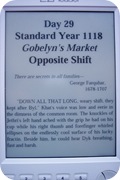 Photo Note: My auto-focus digital camera had a little trouble getting good shots of the screen; no matter what I do, the shots tend to turn out slightly off-focus. The shots may look blurry, but suffice it to say that’s a problem with my camera—in person, the reader is quite as crisp and clear as printed text.
Photo Note: My auto-focus digital camera had a little trouble getting good shots of the screen; no matter what I do, the shots tend to turn out slightly off-focus. The shots may look blurry, but suffice it to say that’s a problem with my camera—in person, the reader is quite as crisp and clear as printed text.
I’ve had more time to play around with the Astak, and the bloom is off the rose. Yes, the e-ink screen is truly amazing, and far clearer than the touch-sensitive Sony reader’s. However, it has certain other problems.
In Praise of Astak
Before I start talking about the Astak’s shortcomings, I should mention that the company itself has some astoundingly good customer service. For one thing, they monitor the Astak forums on MobileRead and pop up to answer questions.
Whenever I have posted a technical question on the forum, I have almost immediately been emailed by an Astak representative with suggestions and offers of advice. Now, granted, I do not know whether this is their default behavior toward all users, or just because they know I’m reviewing their product. I’d like to think the former is true.
Another nice thing about the device itself is that the firmware is remarkably easy to upgrade. Just put the firmware file on an SD card, slide the card in, and reboot into upgrade mode using a combination of keypresses.
My only complaint in this regard is that the instructions I found for upgrading on their website were not entirely clear. One of the buttons to be pressed is mentioned as the “increase volume key”. I assumed that meant the rocker switch on the right—but after that did not work and I searched some more, I learned that those instructions only applied to the 6” Astak reader devices; for the 5”, you press the page-forward button left of the screen instead. Just a little confusing.
Now let’s talk about some of those shortcomings.
Battery Life
One of the things that makes e-ink so great is that it only uses power when you turn the page. The e-ink page uses micro-capsules that are rotated by current, but require no current to stay set as they are. This is why e-ink readers have such a long battery life.
This should mean that, theoretically, an e-ink reader should use almost no power at all when it is “idling”. I should be able to leave it “open,” like a book, for days on end and pick it up with the same battery level that I left off.
(Granted, there may need to be some minor power consumption—but since it is not driving a display, surely it should use less than a digital watch, which is able to run for months on a single tiny battery.)
Unfortunately, this is not the case with the Astak. If I leave it alone for several days and forget to plug it in, the battery drains completely dry—and requires approximately “overnight” to charge back up to full again. This puts a damper on what ought to be one of an e-ink reader’s biggest advantages.
A Peeling Reader
 I also noticed that my sample has started to develop a flaw remarked upon by other Astak users: the peeling paint problem. About half of Astak owners have found that, with a little wear, the paint covering their reader starts to peel off. Here you can see it starting on mine, right around the left page-turn arrows. (You may need to click to enlarge it to see more clearly.)
I also noticed that my sample has started to develop a flaw remarked upon by other Astak users: the peeling paint problem. About half of Astak owners have found that, with a little wear, the paint covering their reader starts to peel off. Here you can see it starting on mine, right around the left page-turn arrows. (You may need to click to enlarge it to see more clearly.)
It is only a cosmetic problem, of course, and Astak’s excellent customer service again comes to the fore: they will, on request, provide replacement units that do not suffer from this flaw. Not everyone even cares about a replacement; one Astak user on the Baen Bar has just peeled all the paint off of his and been quite happy to keep using it that way.
Ex-Calibre
For some reason, I have not been able to make Calibre work with the Astak. I am not sure whether this is the Astak’s problem or some flaw with Calibre (which worked just fine with my Sony).
When I posted to MobileRead about it, it was suggested that I should remove the Chinese language manual from internal memory, as it messes with Calibre’s ability to connect.
I wanted to try to do this, but it seems at the moment I cannot get the reader to connect to my computer’s USB at all. It just shows a “charging” indicator and blinking light, and does not give me a “press Enter to connect” dialogue. But others seem to be able to use Calibre with their devices just fine.
It was not a great handicap, however; I ended up just using an SD card reader to copy my books directly onto my card, which I then put in the Astak. It just takes a few extra steps to make the copy.
If I were going to keep this reader, I might be more concerned about getting Calibre working with it—but since I will be sending it back, I am not going to let it bother me.
Moving on to formats…
Mobipocket vs. ePub
First of all, the majority of the books I read are unencrypted ePub these days, from Baen. I recently downloaded all of my Webscription purchases and put them on a directory of the 2-gig SD card I normally use for my digital camera, and put that in the Astak. The books load right up with no problem.
Reading ePub books on the EZReader is, well, “EZ”. They load quickly, and I am able to access the table of contents, zoom, search, even use the read-aloud feature (once I had updated the firmware to the latest version).
However, a Mobipocket book I read on it did not fare so well. This was 1634: The Baltic War, from one of the Baen CDs hosted on The Fifth Imperium. It was not available in ePub format, so I loaded the Mobi.
I found that, though I was able to read the file, the Astak reader was unable to parse the Mobi table of contents. There was a table of contents I could jump to, but it was all HTML links and I couldn’t figure out how to click on any of those links (if it was even possible at all). I ended up having to use the “jump to page” function in the menu to navigate through the book.
Furthermore, every so often the reader would lose track of my place. I would turn it back on to find myself a few dozen or hundred pages back from where I had been. If I find myself faced with a Mobi-only title in the future (at least while I still have the Astak), I will probably go to the extra trouble to convert it with Calibre first.
eReader and PalmDoc
In email correspondence, Bob Barry, the Director of Global Business Development for Astak, said that the Astak already supports non-DRMed books in Fictionwise’s eReader format, and they are negotiating to add support for eReader DRM as well.
However, I tried testing with three unencrypted eReader books I created myself and that I had verified opened on other devices, and the Astak did not even see them in a directory listing of the SD card. Very disappointing. It appears the Astak may not be the eReader e-reader of my dreams after all.
I was able to open a book in the PalmDoc format, though since it had no table of contents navigation through it would have the same problem as Mobipocket.
Awkward File List Navigation
I should also note that the navigation through the file list is a bit of a pain if you have a large directory. My Baen e-book files take 27 screens to list, alphabetically by title, and there is not any way to jump to specific titles. (Nor can I sort them in any way except title, date, or type, which is not terribly useful in this situation.)
So if I were to want to read Worlds of Honor or Young Miles, I would have to resign myself to paging through 27 pages of files to get to the ones I wanted.
I suppose if I copied my Calibre directory onto the card rather than my unsorted Baen ePub directory I might at least be able to navigate the directory tree by author, but I would still need to know what author wrote the book I wanted.
However, I cannot now remember whether Sony’s file list interface was any better.
 But the PDF format is where the Astak easily falls the shortest. I had expected that, being a more recent device, it should handle PDF files at least as well as the Sony did. (You may wish to read my review of the Sony’s PDF capabilities for comparison purposes.) However, its performance left a number of factors to be desired.
But the PDF format is where the Astak easily falls the shortest. I had expected that, being a more recent device, it should handle PDF files at least as well as the Sony did. (You may wish to read my review of the Sony’s PDF capabilities for comparison purposes.) However, its performance left a number of factors to be desired.
First of all, I loaded the image-only PDF of “Bronte’s Egg”. Full-page, it looked about the same as it did on the Sony, only smaller by an inch. However, when I used the “rotate” option and turned the reader 90 degrees, when I pressed “page forward” the device simply crashed back out to the file list again. I tried multiple times, and it always behaved in this way.
 |
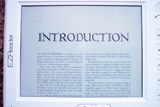 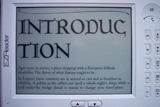 |
Moving on to Dragon Warriors, we see that in both the portrait and landscape versions, the text looks pretty good. The problem comes when we use the “zoom” function, to break the PDF out of its formatting and zoom the text in a few times. The result: the first column on the page is nowhere to be found. The text below the header starts at the beginning of the second column.
(The Sony was not perfect in this regard either, but at least it put the “Introduction” header at the middle of the page and kept the first column of text before it. But no amount of paging up would reveal that first column of text in the Astak.)
 |
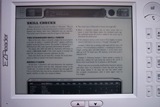  |
Spycraft, the 160-megabyte overformatted bloat-monster, took more than a little time to load, but once it did it looked fairly decent, if much too small to read. Rotating 90 degrees did improve the readability some—but attempting to zoom in further simply zoomed out instead—and it remained zoomed out through each of the several zoom levels, until I finally reached the one that zoomed it back in to its original half-page view.
Also, zooming, rotating, and page-turning were all extremely sluggish—not that I am surprised, given the 160-megabyte size of this monster.
 |
 |
Spirit of the Century, a much smaller book and less-bloated PDF, came off considerably better. The smaller page size meant it is more readable in general on the Astak, and the non-cruft formatting meant it came off considerably better zoomed in as well.
Tables of Discontent
One other annoyance had to do with the table of contents. The Astak would read the PDF’s table of contents, and this included multi-level TOCs such as the one from Spycraft.
In a multi-level table of contents, if I clicked on “4. Chapter 4: Skills” I would get another table of contents, starting off with “1. Chapter 4: Skills” and then listing subheads for 2, 3, and 4.
So assuming I want to start off at the beginning of Chapter 4, I would click 1 for “1. Chapter 4: Skills”, right? Wrong. Clicking 1 would put me back at the main TOC. To go into the chapter, I would need to click 2 or up for one of the subheads. This is not a very intuitive interface design.
Conclusion
Although ePub files are a joy to read on the Astak, other formats are considerably less so—and the interface makes getting to those files somewhat awkward when I have a lot of them. With that in mind, though I am enjoying using it while I have it, I find I will not regret sending it back when the time comes.




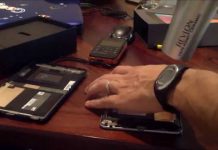








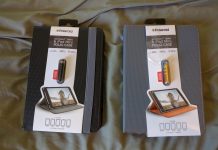


















Good review, thought I should comment on a couple of points.
* File navigation – Yes its a bit of a pain, having to keep pressing the next page key. A nice option, which unfortunately they don’t publicize is that if you keep the next page key pressed for a few seconds, you skip 10 pages instead of one, so if you have 90 pages of files like me, you can skip to reasonably close to the actual file.
* Navigation in Mobipocket – Using the TOC is possible, but unfortunately the documentation is not very clear about how to do so.
When you are on the TOC page, click on the options menu and select “Follow Link”. This brings up a input panel, where you enter the number that appears next to the link you want to follow.
While a little cumbersome it does work, I just wish the documentation was little clearer
Regarding the battery life. As I understand it, just pressing the off button locks the keyboard so that you don’t accidentally press a key, but it doesn’t actually turn off the processor. This lets it turn on quickly, but it doesn’t set it into true low-power mode. A longer press of the off button actually turns it off.
So, if you are someone who charges it every day or so then a keyboard lock is no problem and the battery life is fine. If, however, you intend to leave it alone for a few days you need to turn it off more permanently.
Also, there are reports from a few folks that the battery needs to be conditioned. Wait, before you jump in with claims that these batteries don’t have memory effects, that’s not really the claim. The idea is that since these are smart batteries, the charging chip is the thing that needs to be ‘trained’. It needs to see the maximum and minimum voltage so that it can understand the range that is truly available. I’m not a battery guru, so I can’t report on the truth of this — it could be just an urban myth. However, I have seen many reports from folks who claim success with conditioning this device as well as others with ‘smart’ cell phone batteries.
MLH
Good review — well balanced.
Because of that I just purchased one, and I think it will serve me well.
If TTS worked with Epub and decent voices could be purchased it would be perfect as a handy reader.
Please pardon me but there are some errors of fact in the review that I think your readers should get clarified.
A fix in the form of a firmware update came out two weeks ago on November 5, 2009. I have a Pocket Pro and I installed the update when it came out. I have used it daily for two weeks and still have a full charge.
The Pocket Pro uses folders to store books. They work like directories in MS Windows. In fact, you can put an SD chip in your PC and create the folders in Windows Explorer, then drag-and-drop ebooks into the appropriate folder. For example, I have one called Fiction and one called nonFiction in the root. Under Fiction I have Classics, Science Fiction, etc. Going down I organize them by author’s name. This method works better than putting all your books in the root or top folder.
The Pocket Pro handles PDF files as poorly as other, small eBook readers. PDF was designed to print on 8.5 by 11 paper or view of a larger, PC monitor. The Pocket Pro, like the other 5-inch readers coming out, was designed to be an inexpensive device small enough to fit in a purse or jacket pocket. If a PDF supports reflow, the Pocket Pro will reflow the text, but it has the same flaws as my Sony PRS505, errors that are generic to PDF documents on smaller screens.
No, it handles PDFs somewhat worse than the Sony.
For one thing, the Sony had no issues with reading the “Bronte’s Egg” PDF file. I could turn it 90 degrees and read it half a page at a time with no problem.
When I turned the PDF 90 degrees in the Astak, it crashed when I tried to page down. That’s “worse” in my (e-)book.
Likewise with the missing half a page when it reflowed Dragon Warriors. As I said, the Sony did not lose that first half-page, even if it did put the title in the middle.
Chris, will you be playing with LIT ebooks on the Astak? Since its ability to read LIT format is one of the unique features of this device, and since I have hundreds of LIT ebooks, I’d really like to know how it handles them.
Bev, I recently bought the six inch Astak and found the LIT disappointing….the font was too small, and not adjustable to my taste.
With the Nook here, I really wish Astak would drop the price significantly, (like into the 150.00 range), since it by no means can compete. Then I could buy one paint peeling off and all and be at peace.
Oh, I suppose I should point out, if it isn’t evident enough, that I returned my 6 inch Astak and resumed ebook reader shopping.